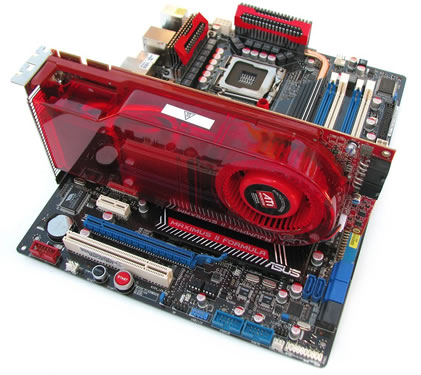With the recent arrival of the Radeon HD 4000 series, graphics cards prices have plummeted to the point where it is now possible to pick up a very powerful gaming solution for just $200.
Just a month ago we reviewed the Radeon HD 4850, the value offering in the new ATI line-up, and in short we absolutely loved it. Since then Nvidia has reconfigured their pricing scheme so that you can pick up either a GeForce 9800 GTX or Radeon HD 4850 for just $200 (the 9800 GTX was previously $300+).
However, if you can spend a little more, AMD also has the Radeon HD 4870 on offer, boasting improved performance on a single GPU for about $285. Competing in the same price range are the Radeon HD 3870 X2 and the GeForce GTX 260 graphics cards, while the GeForce 9800 GX2 and GeForce GTX 280 cost considerably more.
Today we will be taking the Visiontek Radeon HD 4870 card for a spin, comparing it to all of these high-end graphics cards to see how it stacks up both in terms of value and performance.

The specifications of the Radeon HD 4870 are very impressive. The GPU boasts a staggering 800 SPUs (160x5), 40 TAUs and 16 ROPs, making for an extremely complex unit. Compare that to the 320 SPUs (64x5), 16 TAUs and 16 ROPs of the previous generation Radeon HD 3870, and you can begin to understand the number of changes AMD has put forth on this new graphics series. The Radeon HD 4870 has a memory bandwidth of 115.2GB/s, while the older Radeon HD 3870 was limited to 57.6GB/s.
This huge boost in memory bandwidth is the result of using the latest GDDR5 memory which is clocked at 900MHz (1.8GHz x 2 = 3.6Gbps), while the GPU core operates at 750MHz (1.2 TFLOPs of computing power), up from the 625MHz core clock of the Radeon HD 4850. Besides the obvious advantage in core speed and memory spec, the Radeon HD 4870 and 4850 GPUs share similar specifications.
The Radeon HD 4870 GPU has been built using a 55nm design process and features a 256-bit wide memory bus. Like the older Radeon HD 3000 series, the new 4000 series also uses the PCI Express 2.0 bus, though it is compatible with PCIe 1.0 motherboards. Unlike most recent GeForce releases, the Radeon HD 4000 series offers full support for DirectX 10.1, which may prove useful in the future. Also, you can expect to see 1GB and 512MB versions of the Radeon HD 4870. Today's sample from Visiontek features 512MB of on-board GDDR5 memory.